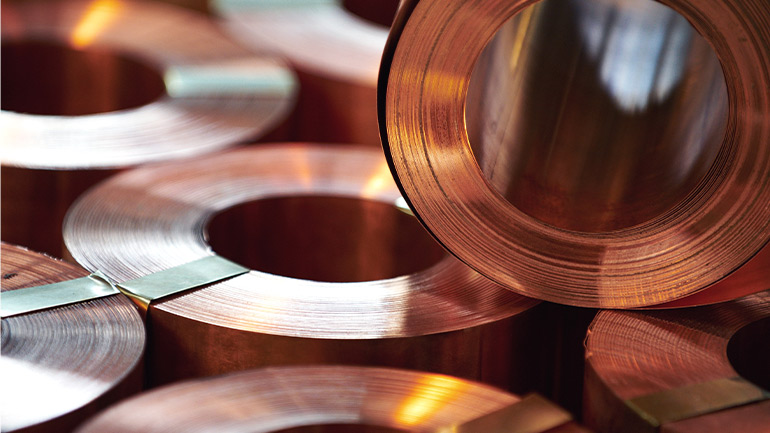Interruption du supercycle du cuivre
Par : Bart Melek
août 22, 2024 - 4 minutes 30 secondes
La faiblesse de la Chine, les craintes d’une récession aux États-Unis et le resserrement inattendu de la politique de la Banque du Japon font chuter le cuivre par rapport à son sommet
L’intérêt exceptionnel des gestionnaires de fonds spéculatifs, comme les fonds de couverture spécialisés, qui a été soutenu par l’optimisme à long terme à l’égard du cuivre en raison de la transition énergétique et des prévisions de déficit pour 2024, a entraîné une remontée plus tôt cette année. Les prix ont atteint un sommet de 11 105 $ US la tonne en mai et sont restés près de 10 000 $ US la tonne en juillet. Jusqu’à tout récemment, le cuivre surpassait les actions américaines, le marché obligataire, l’or et les autres métaux industriels.
Cette remontée a eu lieu malgré le fait qu’il y avait très peu de signes d’une forte demande ou d’un marché serré en Chine. Même si l’on prévoit une offre insuffisante du métal, il semble qu’il y en ait plus qu’assez en ce moment, en grande partie parce que la Chine est le plus important acheteur de cuivre. Les données de bourses partout dans le monde, notamment la London Metal Exchange, la Bourse de Shanghai et la CME, montrent que les stocks globaux de ce métal ont atteint des sommets inégalés depuis mai 2024.
Toutefois, la surperformance du cuivre a récemment pris fin. Les écarts calendaires se sont effondrés depuis mai, et le segment à court terme de la courbe est très faible. Étant donné que la Chine n’a pas mis en œuvre les mesures de relance prévues, qui, selon le marché, auraient sorti le secteur de l’habitation et l’économie en général de leur marasme, on craint de plus en plus que ces événements, conjugués à un ralentissement probable aux États-Unis, entraînent un déclin de la croissance de la demande de cuivre.
En plus d’une hausse inattendue du taux directeur de la Banque du Japon, ces facteurs ont incité les investisseurs à réduire leur exposition aux opérations de portage sur le yen, ce qui a réduit l’effet de levier et miné l’enthousiasme à l’égard des positions acheteur sur le métal rouge, faisant baisser les prix. Cette baisse des prix a été aggravée par un effet d’entraînement négatif causé par les négociateurs techniques et les fonds systématiques de suivi des tendances (conseillers en négociation de produits de base).
La faiblesse de la Chine et les craintes économiques aux États-Unis mettent fin à la surperformance du cuivre
Puisque la faiblesse économique est en train de devenir une caractéristique distinctive des deux plus grandes économies mondiales, on craint de plus en plus que la demande (construction, produits industriels) ralentisse et que le marché du cuivre ne soit pas serré l’an prochain. En effet, nous prévoyons une offre légèrement excédentaire, ce qui signifie habituellement que la remontée des prix sera beaucoup plus modeste que ce que bon nombre d’observateurs du marché prévoyaient il y a quelques semaines à peine.
En plus de l’essoufflement de l’économie chinoise, les États-Unis penchent vers le protectionnisme, imposant des droits de douane à Beijing sur une panoplie de biens, des véhicules électriques aux batteries, en passant par les semi-conducteurs et les modules solaires. L’Union européenne a annoncé des droits de douane sur les véhicules électriques chinois à batterie seulement en juillet, et le Canada adopte également un mode protectionniste bien défini. En même temps, l’offre minière devrait culminer en 2026, car la production devrait augmenter de 4,6 % et de 4,8 % en 2025 et en 2026, respectivement, ce qui est beaucoup plus rapide que la demande, qui devrait augmenter en moyenne d’un peu plus de 3 % au cours des deux prochaines années.
Même si nous ne prévoyons pas de correction soutenue, compte tenu de l’assouplissement imminent de la Fed et de certaines améliorations cycliques de la demande, nous nous attendons à une reprise relativement anémique par rapport aux creux actuels au cours des 12 prochains mois. Les prix auront probablement de la difficulté à dépasser la barre des 10 000 $ US la tonne pendant une période prolongée l’an prochain, ce qui retardera le supercycle du cuivre, souvent invoqué. Cependant, il y a un risque de dégringolade des prix si les États-Unis venaient à tomber en récession. Historiquement, le cuivre a chuté de 10 % à 60 % du sommet au creux en période de contraction.
Le supercycle du cuivre est interrompu, mais pas terminé
Après que l’offre minière aura atteint un sommet en 2026 et par la suite, l’offre découlant de nouveaux projets devra répondre à la demande qui sera soutenue par la transition énergétique. Malgré une période de croissance de la production minière supérieure à la moyenne à court terme, le cuivre est toujours confronté à un déficit structurel sur le marché des métaux affinés. Étant donné que les stocks en jours de consommation se situent sous la moyenne à long terme de 65 jours jusqu’en 2033, ce resserrement devrait soutenir considérablement les prix, selon Woodmac.
Le défi réside dans la capacité du secteur à construire de nouvelles mines à temps pour suivre la croissance de la demande. En raison de la faiblesse de l’économie au cours des 12 prochains mois, nous risquons de constater une perte d’intérêt à l’égard des nouveaux investissements dans les capacités minières, ce qui donne à penser que les projets proposés seront retardés ou ne trouveront pas d’investisseurs. Si la demande augmente et que l’offre n’augmente pas, les prix pourraient bien grimper.
En même temps, la piètre qualité du minerai, les régions difficiles, la pénurie de main-d’œuvre qualifiée et les coûts élevés des biens d’équipement sont tous des facteurs qui portent à croire que les prix du cuivre pourraient devoir être nettement plus élevés pour encourager la construction de nouvelles mines.
De plus, les exploitants de mines sont confrontés à un nationalisme des ressources qui pourrait prendre la forme de taxes beaucoup plus élevées ou d’autres redevances aux gouvernements, de perturbations géopolitiques comme la guerre ou de problèmes liés aux permis (p. ex., la fermeture récente d’une importante mine de cuivre au Panama). Cela donne à penser que ces risques devraient ajouter une prime aux prix du cuivre à long terme dans un avenir plus lointain, car ils limiteront la croissance primaire et feront grimper les coûts.
Il y a des risques que la croissance de la demande ne se concrétise pas comme prévu en raison de facteurs politiques, d’un manque d’acceptation sociale, de coûts élevés et de problèmes d’infrastructures. Dans l’ensemble, nous pensons que les risques laissent entrevoir une hausse des prix du cuivre à long terme, mais pas avant une période de faiblesse au cours de la prochaine année environ, alors que les stocks élevés et le ralentissement de la croissance économique pèsent sur les prix.
Les clients qui s’abonnent peuvent lire le rapport Copper Supercycle Interrupted, en entier sur le portail Une seule TD






